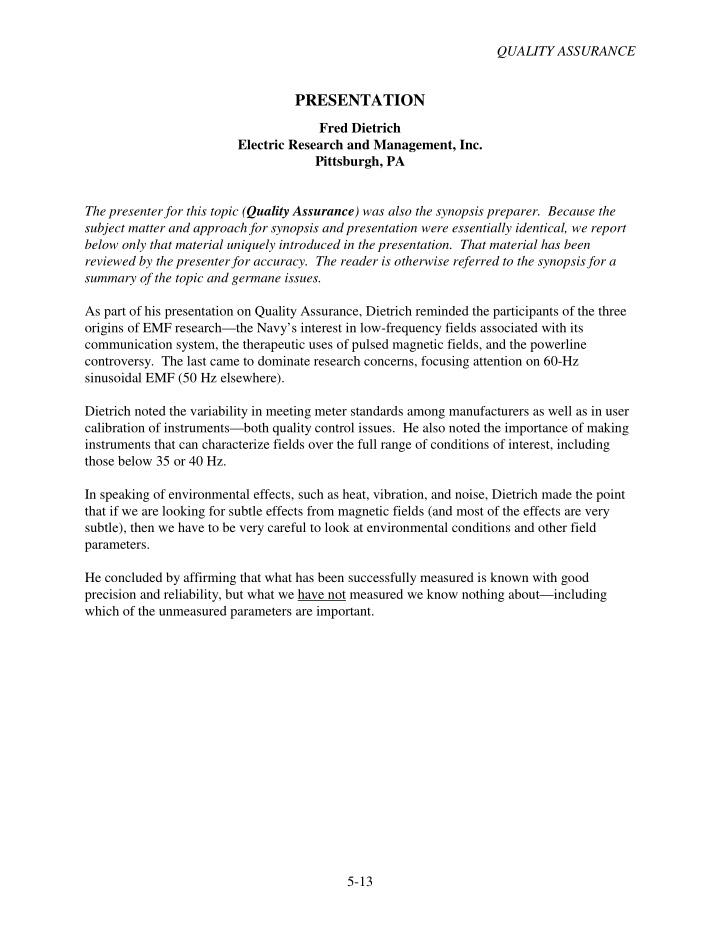



QUALITY ASSURANCE PRESENTATION Fred Dietrich Electric Research and Management, Inc. Pittsburgh, PA The presenter for this topic ( Quality Assurance ) was also the synopsis preparer. Because the subject matter and approach for synopsis and presentation were essentially identical, we report below only that material uniquely introduced in the presentation. That material has been reviewed by the presenter for accuracy. The reader is otherwise referred to the synopsis for a summary of the topic and germane issues. As part of his presentation on Quality Assurance, Dietrich reminded the participants of the three origins of EMF research—the Navy’s interest in low-frequency fields associated with its communication system, the therapeutic uses of pulsed magnetic fields, and the powerline controversy. The last came to dominate research concerns, focusing attention on 60-Hz sinusoidal EMF (50 Hz elsewhere). Dietrich noted the variability in meeting meter standards among manufacturers as well as in user calibration of instruments—both quality control issues. He also noted the importance of making instruments that can characterize fields over the full range of conditions of interest, including those below 35 or 40 Hz. In speaking of environmental effects, such as heat, vibration, and noise, Dietrich made the point that if we are looking for subtle effects from magnetic fields (and most of the effects are very subtle), then we have to be very careful to look at environmental conditions and other field parameters. He concluded by affirming that what has been successfully measured is known with good precision and reliability, but what we have not measured we know nothing about—including which of the unmeasured parameters are important. 5-13
QUALITY ASSURANCE SUMMARY OF DISCUSSION Discussion under this topic, which was presented by Fred Dietrich, presumed that quality control was a necessity, and focused instead on specific sub-issues, as noted below. The summary below was prepared from the transcript. One recommendation was the continued investigation into causes of unsuccessful replications of research findings. Rather than simply attempting to re-replicate an experiment, one should try to "mine" unsuccessful replications for clues until one may understand why and what is occurring before any successive attempts to replicate . Only then may a true replication be achieved. A recommendation was made that radio frequency (RF) and ELF both needed to be accounted for in studies. Dietrich indicated that shielding can be placed in the laboratory to block RF (although there is no indication that RF is correlated with EMF). A discussant noted that little recognition was made of factors such as heating and ventilation. Dietrich agreed, and noted that there appeared to be no real problem in characterizing fields, but that no, or limited, recognition was given to the roles of transients, static field, sham field, temperature, and so on. Other problems included the limited use of double-blind experiments, the lack of positive controls, and the lack of replication and sham/sham experiments. For real-world characterization, Dietrich felt that researchers should put their resources into comprehensive measurements to understand what the field parameters are. This approach would capture information about low-frequency fields, such as 12-Hz fields from rotating tires, 400-Hz fields in aircraft and fields from industrial sealers. Other possibly relevant factors that were identified by discussants were light level and spectrum, exposure history of animals, exposure of cells and bioassays during shipping, and variations in background static fields. In response to a question regarding changing static fields, Dietrich indicated that some laboratories use shielding, while others use a set of coils to modify the static field. However, the researcher may not be able to compensate for the presence of magnetism from commercial incubators or a passing elevator. A question was also raised regarding the application of quality control: should the design of the study itself be rated (evaluated for quality control) separately from implementation of that design? The discussant felt that, in the case of epidemiological studies, a distinction should be made between how well the researcher measures the parameter, and how good the parameter itself is. The example given was the use of distance as a surrogate: the quality issues associated with determining the actual distance are quite different from the quality issues of using this measure as a surrogate for exposure. In the general discussion following Session #1, a topic that embraced all the preceding presentations was: whether we are now in a position to make a hazard evaluation of extremely low frequency EMF, based on existing information. 5-14
QUALITY ASSURANCE Misakian responded that one cannot make such an evaluation with confidence because of the lack of replication for literally hundreds of reported effects. Bailey stressed the distinction between research for purely scientific purposes, and research carried out for hazard identification. For the latter, the researcher must make a decision based on what is known now, not 20 years from now. Based on many years of research and thousands of studies, we should be able to make some generalizations today. Johnson and Dietrich agreed that the technology is in place to produce accurate measurements. Dietrich further ventured the opinion that we have the quantification to say whether time-weighted exposure to power frequency fields is a hazard. However, he cannot speak to this question for ELF fields. He further said that the fact that the same experiment cannot be replicated in two places is due not to differences in 60-Hz time-weighted fields but to some other parameter. Submitted written comments on this topic are found in Appendix C. 5-15
QUALITY ASSURANCE This page intentionally left blank. 5-16
Recommend
More recommend